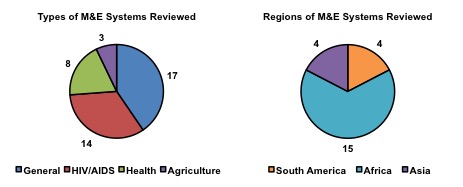Evaluating Government Monitoring & Evaluation Systems of Aid-Recipient Countries
“Aid effectiveness is more than a moral imperative; it is a task of great economic urgency. But we still have a long way to go.” – OECD Secretary-General Ángel Gurría at the 2011 High Level Global Development Forum on Aid Effectiveness
Since 2005, when major donors endorsed the Paris Declaration on Aid Effectiveness, governments and aid organizations have prioritized improving the quality of aid so as to increase its development impact. A major part of the agenda on aid effectiveness is increasing country (i.e., aid recipient) capacities for monitoring and evaluation (M&E) of activities, outputs, and outcomes financed by aid.

Earlier this year, the Evans School Policy Analysis and Research (EPAR) Group at the University of Washington prepared a report reviewing developing country governments’ approaches to results monitoring and evaluation, to evaluate the level of development of national M&E systems.
Data included frameworks, strategies, and peer reviews of 42 distinct national government M&E systems in 23 developing countries. Of the 42 M&E systems examined, almost half were general national systems, measuring results across multiple sectors. The remaining systems were focused on specific sectors, including HIV/AIDS, health, and agriculture (Figure 1).

Figure 1: National M&E Systems for Aid in 23 Developing Countries
EPAR rated each M&E system for its effectiveness and quality using a set of 93 questions covering institutionalization, coordination, and harmonization of the system as well as processes for collecting, analyzing, and using the results data (Figure 2).

Figure 2: Flow of Information and Resources in National M&E Systems
Perspectives on National Government M&E Systems
From the donor perspective, the cost of implementing their own systems for monitoring and evaluating the effectiveness of aid programs may exceed the benefits – aid could be more efficiently monitored and evaluated if these capacities were shared across donors via a national M&E system. From the recipient government perspective, multiple uncoordinated donor M&E systems increase reporting burdens and make it difficult to allocate scarce monitoring resources to building and maintaining national capacity for M&E.
Developing national M&E systems, paired with harmonization of M&E protocols across donors and recipient governments, has been proposed as a possible pathway for alleviating these concerns. International agreements such as the Paris Declaration and subsequent Accra Agenda commit aid recipients and donors to better align their M&E systems. A 2011 OECD study, however, highlighted that only one of 13 Paris Declaration donor aid effectiveness targets for 2010 had been met. Donors’ failure to meet commitments to enhance harmonization with recipient country M&E systems makes it less likely that national M&E systems will improve and more likely that donors continue to implement their own separate M&E systems.
Research Findings
EPAR finds that national M&E systems of aid recipient countries vary widely in their levels of development. Most governments are increasingly emphasizing the importance of M&E and have plans in place for developing their national systems. Many countries, however, continue to face challenges from limited coordination of M&E activities across government sectors and levels, inadequate resources and capacities for M&E, and lack of clear rules and standards for data collection, analysis, and review. Further, though the number of separate donor systems is falling in many countries, donors’ ongoing use of parallel results measurement systems reduces the resources available to develop national M&E systems.
Three blog posts will follow in this series to further present the evidence and trends from EPAR’s research into aid-recipient government M&E systems. These posts will be organized around three fundamental questions:
- Are government M&E systems effectively institutionalized and coordinated?
- Are government M&E systems results data effectively collected, analyzed, and used?
- Are government and development partner M&E systems effectively aligned and harmonized?
The posts on government M&E systems will be followed by a second series of posts summarizing EPAR’s research on donor results measurement systems, exploring further issues in monitoring and evaluating aid effectiveness.
This series is guest-written by the Evans School Policy Analysis and Research (EPAR) Group at the University of Washington in collaboration with Development Gateway and the Results Data Initiative.
Share This Post
Related from our library

Harnessing the Power of Data: Tackling Tobacco Industry Influence in Africa
Reliable, accessible data is essential for effective tobacco control, enabling policymakers to implement stronger, evidence-based responses to evolving industry tactics and public health challenges. This blog explores how Tobacco Industry strategies hinder effective Tobacco control in Africa, and highlights how stakeholders are harnessing TCDI Data to counter industry interference.

Building a Sustainable Cashew Sector in West Africa Through Data and Collaboration
Cashew-IN project came to an end in August 2024 after four years of working with government agencies, producers, traders, processors, and development partners in the five implementing countries to co-create an online tool aimed to inform, support, promote, and strengthen Africa’s cashew industry. This blog outlines some of the key project highlights, including some of the challenges we faced, lessons learned, success stories, and identified opportunities for a more competitive cashew sector in West Africa.

Digital Transformation for Public Value: Development Gateway’s Insights from Agriculture & Open Contracting
In today’s fast-evolving world, governments and public organizations are under more pressure than ever before to deliver efficient, transparent services that align with public expectations. In this blog, we delve into the key concepts behind digital transformation and how it can enhance public value by promoting transparency, informing policy, and supporting evidence-based decision-making.